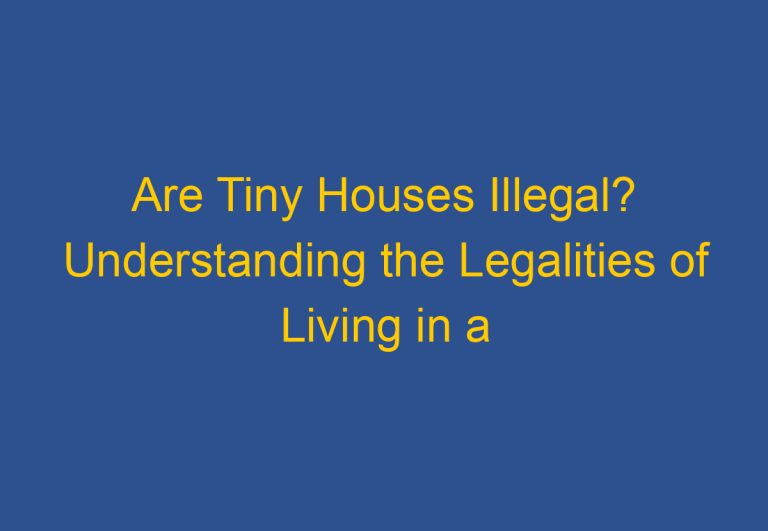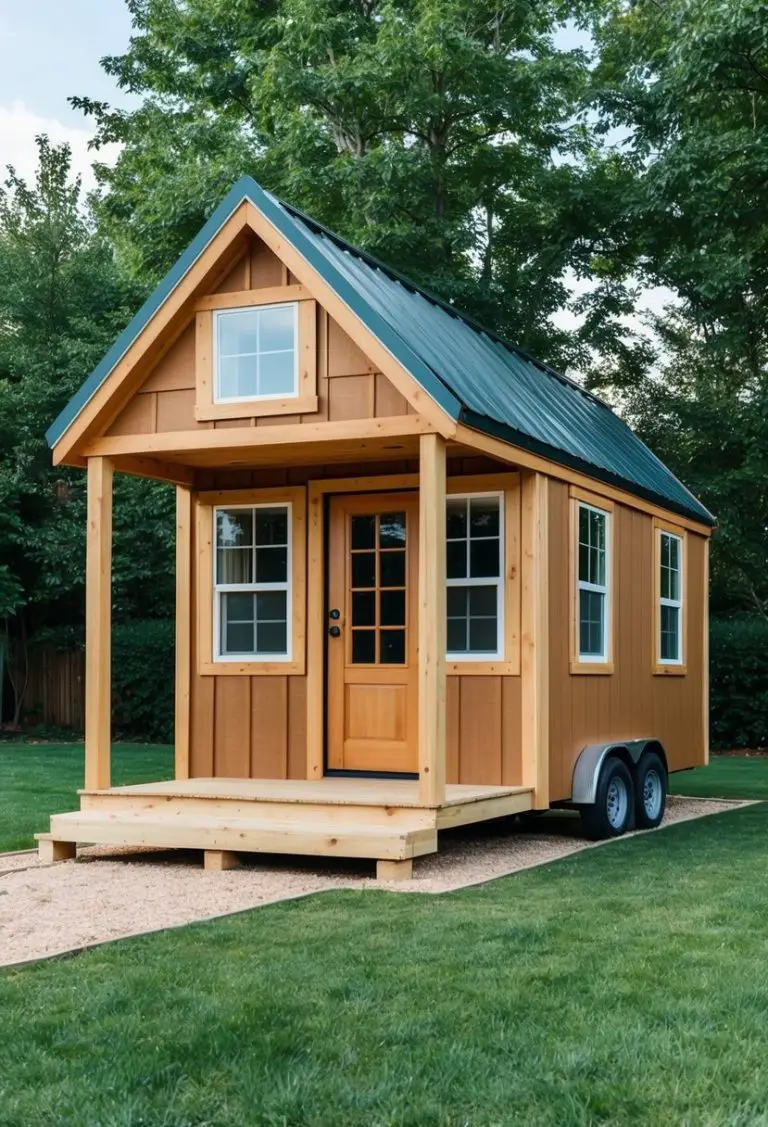Where Can I Put a Tiny House in Maryland: A Comprehensive Guide
Maryland is a state that is known for its beautiful landscapes, rich history, and diverse communities. It is also a state where the tiny house movement has gained popularity in recent years. The idea of living in a small, functional, and affordable home has attracted many people who want to simplify their lives and reduce their environmental impact. However, the question of where to put a tiny house in Maryland can be a challenge.
One option for placing a tiny house in Maryland is to find a community that is designed for small homes. There are several tiny house communities in Maryland that offer a range of amenities and services to residents. These communities often have zoning and building regulations that are tailored to tiny homes, which can make it easier to get permits and approvals. Additionally, living in a tiny house community can provide a sense of community and support that can be difficult to find when living in a traditional home.
Another option for placing a tiny house in Maryland is to find private landowners who are willing to rent or lease their property. This can be a good option for people who want to live off-grid or in a rural area. However, it is important to make sure that the landowner is aware of the regulations and zoning requirements for tiny homes in Maryland. Additionally, it is important to have a clear agreement in place that outlines the terms of the rental or lease, including utilities, parking, and other amenities.
Understanding Tiny House Regulations in Maryland
When it comes to tiny house regulations in Maryland, there are several important factors to consider. These include state and county zoning laws, building codes and standards, and land use and zoning ordinances. Understanding these regulations is crucial for anyone looking to build or live in a tiny house in Maryland.
State and County Zoning Laws
Maryland is a state that allows tiny houses, but local authorities have the power to regulate zoning and land use. This means that tiny house regulations can vary from county to county. Some counties in Maryland that allow tiny houses include Montgomery, Baltimore, and Garrett. However, it is important to note that each of these counties has its own set of rules and regulations that must be followed.
Building Codes and Standards
To be considered a permanent residence, tiny houses on a foundation in Maryland must adhere to international building codes. Tiny houses on wheels, on the other hand, require a durable design and careful consideration. According to the Maryland Building Performance Standards, a dwelling unit must have at least 120 square feet of living space, with at least one habitable room of at least 70 square feet. This means that a tiny house in Maryland must have a minimum of 190 square feet of living space.
Land Use and Zoning Ordinances
In addition to building codes and zoning laws, land use and zoning ordinances must also be considered when building or living in a tiny house in Maryland. These ordinances regulate the use of land and dictate where and how tiny houses can be placed on a property. Some of the rules and regulations to consider include minimum square footage, setbacks, utility connections, parking, and permits.
Overall, understanding tiny house regulations in Maryland is important for anyone looking to build or live in a tiny house in the state. By following these regulations, one can enjoy the benefits of living in a tiny house in Maryland without running afoul of the law.
Finding a Location for Your Tiny House
When it comes to finding a location for your tiny house in Maryland, there are a few options to consider. Whether you’re looking to buy land or rent space in a community, there are a few things to keep in mind to ensure that your tiny home is located in a safe and legal area.
Private Land and Communities
If you’re looking to buy land for your tiny house in Maryland, it’s important to do your research and make sure that the land is zoned for residential use. You may also want to consider purchasing land in a tiny house community, which can offer a sense of community and support for those living in tiny homes.
One popular tiny house community in Maryland is Blue Moon Rising, located in Garrett County. This community offers eco-friendly tiny homes for rent, as well as space for those who want to bring their own tiny homes. Another option is Liberty Village, located in Annapolis, which offers tiny home lots for sale.
RV Parks and Accessory Dwelling Units
Another option for those looking for a place to park their tiny house in Maryland is an RV park or campground. Many of these locations offer space for tiny homes on wheels, as well as access to amenities like electricity and water.
For those looking to live in a tiny house on a more permanent basis, an accessory dwelling unit (ADU) may be a good option. ADUs are small, standalone structures that can be built in a backyard or on a piece of private land. Montgomery County, for example, allows for the construction of ADUs on certain properties.
Overall, there are a variety of options available for those looking to live in a tiny house in Maryland. Whether you’re looking to buy land, rent space in a community, or park your tiny home in an RV park or ADU, it’s important to do your research and make sure that you’re following all local zoning and building regulations.
Frequently Asked Questions
What are the zoning regulations for tiny houses in Maryland?
Zoning regulations for tiny houses in Maryland vary depending on the county. In general, tiny houses on wheels are often treated as recreational vehicles and are subject to the same zoning regulations as RVs. However, tiny houses on a foundation are usually subject to the same zoning regulations as traditional homes. It’s important to research the specific zoning regulations in your county before deciding where to place your tiny house.
Are there any tiny house communities in Maryland where I can place my home?
Yes, there are several tiny house communities in Maryland where you can place your home. These communities often have zoning regulations that are more accommodating to tiny houses, and they offer a sense of community and support for tiny house living. Some examples of tiny house communities in Maryland include the Escape Village at Canoe Bay, the Tiny House Village at St. Michaels, and the Cedar Springs Tiny Village.
Can I legally live in a tiny house on my own land in Maryland?
Yes, it is possible to legally live in a tiny house on your own land in Maryland. However, there are certain regulations that you must follow. For example, your tiny house must meet the minimum square footage requirements set by the Maryland Building Performance Standards, and it must have at least one habitable room of at least 70 square feet. Additionally, you may need to obtain a building permit and comply with other zoning regulations in your county.
What counties in Maryland are most accommodating to tiny houses?
Some of the counties in Maryland that are most accommodating to tiny houses include Montgomery, Baltimore, and Garrett. These counties have zoning regulations that are more accommodating to tiny houses, and they may allow you to place your tiny house on your own land or in a tiny house community.
Are there specific areas in Maryland where tiny house living is off-grid permissible?
Yes, there are specific areas in Maryland where tiny house living is off-grid permissible. These areas are often located in rural or remote parts of the state, and they may not have access to utilities such as electricity or water. If you are interested in off-grid tiny house living in Maryland, it’s important to research the specific regulations and requirements in your county.
How do prefab tiny home regulations differ from custom-built ones in Maryland?
In Maryland, prefab tiny homes are subject to the same regulations as custom-built ones. However, prefab homes may be subject to additional regulations if they are classified as manufactured homes. It’s important to research the specific regulations and requirements for prefab tiny homes in your county before deciding to purchase one.










